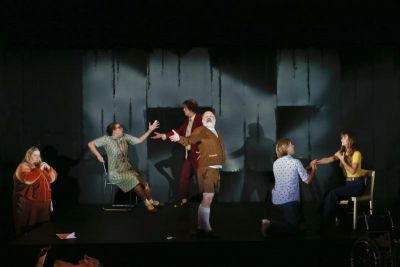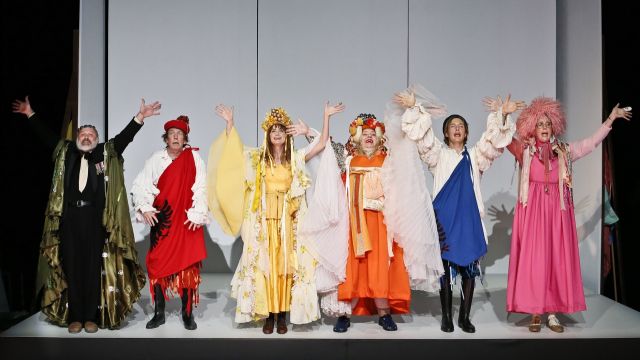Cosi
As the program tells us, Louis Nowra’s 1992 Cosi is ‘performed around the world… and is produced by between 20 and 30 amateur companies every year in Australia’. Seeing it again after many years, we can see why. Despite being – probably – politically incorrect (laughing at the disabled?) – the play is, first, very funny. Mr Nowra makes us care about his mental patients without any pussy-footing sentimentality. Second, it has heart: a group of misfits with disabilities overcome those disabilities and come together to make something. That something may be ridiculous, but the point and the strength of the play is how much that something means to these characters.
Then there are the ‘acting opportunities’ in a cast of eccentric but recognisable characters – as well as supposedly ‘normal’ characters such as our hero Lewis (here Sean Keenan) or his boringly politically correct girlfriend, Lucy (Esther Hannaford). Lewis, a naïve and broke recent uni graduate, is hired by glibly optimistic social worker Justin (George Zhao) to direct mental asylum patients in a show. Quite a challenge when the assembled cast exhibit a range of mental disorders and one, bipolar Roy (Robert Menzies), insists on Mozart and Da Ponte’s Così fan tutte…
 For the patients, Katherine Tonkin gives a nicely restrained, slow-burn performance as OCD Ruth. Glen Hazeldene as older, silent Henry comes into his own in the second half and owns the play in his sequences. Rahel Romahn is a delight as sex-obsessed pyromaniac Doug and Bessie Holland as eating disorder Cherry constantly gives the show the oomph it sometimes needs, brilliantly combining simultaneous comedy and pathos. Ms Hannaford doubles as drug addict Julie in a – for her – surprisingly under-powered performance. But what a pleasure it is to see Robert Menzies, so often the recessive sad sack, in the role of the desperate would-be thespian Roy, fired up and firing, aggressive, acerbic, wilful and yet achingly sad as well – and funny. A terrific, layered performance. Director Sarah Goodes yet again demonstrates her talent for physical and character comedy, fittingly in this case keeping performances big, bright and broad.
For the patients, Katherine Tonkin gives a nicely restrained, slow-burn performance as OCD Ruth. Glen Hazeldene as older, silent Henry comes into his own in the second half and owns the play in his sequences. Rahel Romahn is a delight as sex-obsessed pyromaniac Doug and Bessie Holland as eating disorder Cherry constantly gives the show the oomph it sometimes needs, brilliantly combining simultaneous comedy and pathos. Ms Hannaford doubles as drug addict Julie in a – for her – surprisingly under-powered performance. But what a pleasure it is to see Robert Menzies, so often the recessive sad sack, in the role of the desperate would-be thespian Roy, fired up and firing, aggressive, acerbic, wilful and yet achingly sad as well – and funny. A terrific, layered performance. Director Sarah Goodes yet again demonstrates her talent for physical and character comedy, fittingly in this case keeping performances big, bright and broad.
The text specifies that the old hospital theatre smells of ‘burnt wood and mould’, so designer Dale Ferguson makes it all gloomy black with curling panels, a challenge for lighting designer Niklas Pajanti. As a naturalistic (more or less) play, the set needs the credible space of an old theatre or rehearsal room. Here Ms Goodes and Mr Ferguson opt to use the entire width and depth of the Sumner stage which tends to keep the characters somewhat remote from us – and makes the many scene to scene transitions difficult. Interestingly, as the play builds to its climax, the raised stage rostrum, on which the cast has rehearsed, is rolled downstage, taking the action closer to us – where perhaps it should’ve been all along. But Jonathan Oxlade’s costumes are just right for character and the 1971 setting.
 There is a political context to this 1971 setting: it’s the time of the Vietnam moratorium demonstrations and Lewis’ doctrinaire girlfriend Lucy and his mate Zac (Gabriel Fancourt) are dismissive of Lewis’s attempt to bring together his production of Così fan tutte with a cast that cannot speak Italian, sing or act. In the process, of course, Lewis becomes a better, stronger human being, but really that political context is no longer so significant (and Lucy’s dialogue is heavy-handed clunko). Lewis’ personal growth takes second place: he becomes a vehicle or enabler for his more moving, more entertaining cast of mental patients. Mr Keenan – an accomplished screen actor – could also perhaps give his Lewis more theatrical energy and attack: the performances of the others are overwhelming his, exacerbating the problem.
There is a political context to this 1971 setting: it’s the time of the Vietnam moratorium demonstrations and Lewis’ doctrinaire girlfriend Lucy and his mate Zac (Gabriel Fancourt) are dismissive of Lewis’s attempt to bring together his production of Così fan tutte with a cast that cannot speak Italian, sing or act. In the process, of course, Lewis becomes a better, stronger human being, but really that political context is no longer so significant (and Lucy’s dialogue is heavy-handed clunko). Lewis’ personal growth takes second place: he becomes a vehicle or enabler for his more moving, more entertaining cast of mental patients. Mr Keenan – an accomplished screen actor – could also perhaps give his Lewis more theatrical energy and attack: the performances of the others are overwhelming his, exacerbating the problem.
The text per se, however, takes on the problem of keeping an ensemble in balance and giving each character an ‘aria’ - as Mr Nowra puts it. This means that the play does proceed in fits and starts, at times impeding its own momentum and doubling back on itself. Fortunately, this great cast overcomes this flaw, maintaining the energy and avoiding any frustration at the numerous – if necessary – reversals and making us invest in the patients’ ‘coming out of themselves’ (as the dopey Justin puts it), the real point of the play. The clumsy exuberance of their uninhibited final performance is so well done that the continuation into wrap-up and resolution that follows is rendered unnecessary.
Anyone who’s been part of a theatrical show or a film shoot - or any team that believes in the enterprise - knows the camaraderie, the sense of belonging and the esprit de corps that can be created – and sorely missed when the show is over. This production of Cosi brings that movingly to life.
Michael Brindley
Photographer: Jeff Busby
Subscribe to our E-Newsletter, buy our latest print edition or find a Performing Arts book at Book Nook.

